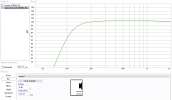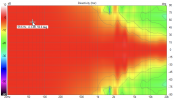I'm thinking of building a pair of 7" wide mini-towers with a sensitivity of 106 db/w, using the following drivers (chosen for their smooth frequency response):
The full-range drivers, placed in close proximity, should act like a line array up to approximately 1600 Hz (the space between driver cone centers will be about 105 mm). This assumes that the 1/2 wavelength rule for line arrays applies in my case. If I need to use the 1/4 wavelength rule, I can switch to smaller 3-inch full-range drivers with little loss in sensitivity.
Do you think this is doable, or am I missing something?
Driver specs:
- 4x Lavoce FSF041.00 4" full-range drivers (88 db/w)
- 1x Lavoce DF10.142LM 1" compression driver (106 db/w)
- 1x Lavoce HD1004 horn (1200 Hz cutoff frequency)
The full-range drivers, placed in close proximity, should act like a line array up to approximately 1600 Hz (the space between driver cone centers will be about 105 mm). This assumes that the 1/2 wavelength rule for line arrays applies in my case. If I need to use the 1/4 wavelength rule, I can switch to smaller 3-inch full-range drivers with little loss in sensitivity.
Do you think this is doable, or am I missing something?
Driver specs:






